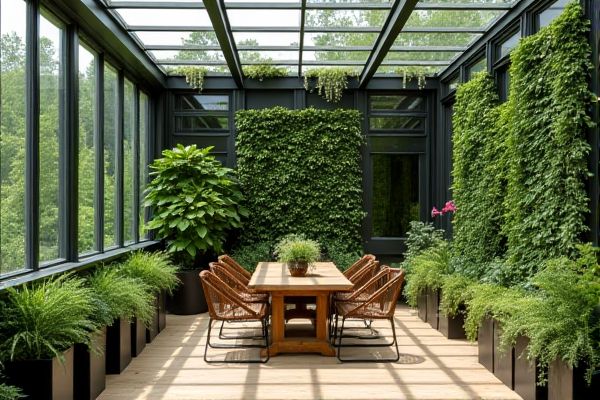
Vertical gardens maximize space by utilizing walls to grow plants upward, making them ideal for small sunrooms with limited floor area. Container gardens offer flexibility in plant placement and variety but require more floor space; explore the rest of the article to discover which approach best suits your sunroom and gardening goals.
Table of Comparison
| Feature | Vertical Garden | Container Garden Sunroom |
|---|---|---|
| Space Efficiency | Maximizes vertical space, ideal for small areas | Requires floor space for containers, suitable for larger sunrooms |
| Plant Variety | Best for small plants, herbs, and climbers | Supports diverse plant sizes, including large plants and shrubs |
| Sunlight Exposure | Plants receive direct sunlight vertically; easy to arrange by light needs | Containers can be moved to optimize sun exposure; flexible placement |
| Watering & Drainage | Requires efficient drainage system; drip irrigation often used | Container drainage varies; easy to manage individual watering |
| Maintenance | Moderate, requires periodic pruning and cleaning | High, due to individual container care and potential repotting |
| Installation & Setup | Needs wall mounting or frame; initial effort can be higher | Simple setup; containers can be arranged or replaced anytime |
| Aesthetic Appeal | Creates living walls; modern and space-saving design | Flexible design options; variety of containers and plant combinations |
| Cost | Potentially lower long-term cost; moderate initial investment | Costs vary by container size and plant quantity; generally higher |
| Ideal For | Small spaces, urban apartments, decorative green walls | Spacious sunrooms, large plant collections, versatile gardening |
Introduction to Vertical Gardens and Container Gardens in Sunrooms
Vertical gardens maximize limited sunroom space by growing plants upward, using wall-mounted planters or trellises to create lush, green walls that improve air quality and aesthetics. Container gardens offer flexibility by using pots and planters arranged on shelves or floors, suitable for various plant types and allowing easy rearrangement based on light conditions. Your choice depends on sunroom size, available sunlight, and the types of plants you want to nurture for an efficient indoor gardening experience.
Space Efficiency: Vertical vs Container Gardens
Vertical gardens maximize space efficiency by utilizing wall surfaces and growing plants upward, making them ideal for small sunrooms with limited floor area. Container gardens require more floor space and can quickly become crowded, limiting the number of plants you can grow in your sunroom. Choosing a vertical garden allows you to optimize your space while maintaining a diverse and lush indoor garden environment.
Aesthetic Appeal and Design Flexibility
Vertical gardens maximize space with their sleek, wall-mounted plant arrangements, offering a modern and visually striking focal point for sunrooms. Container gardens provide greater design flexibility through varied pot sizes, shapes, and materials, allowing customization to match any aesthetic or room decor. Both options enhance natural beauty and air quality, but vertical gardens excel in creating sculptural greenery while container gardens offer dynamic and changeable layouts.
Sunlight Utilization and Light Distribution
Vertical gardens maximize sunlight utilization by exposing plants to greater surface area, allowing your sunroom plants to receive more direct light throughout the day. Container gardens often have limited exposure due to pot placement and shadowing, reducing efficient light distribution. Optimizing plant arrangement in vertical systems improves photosynthesis and growth by evenly distributing natural sunlight across all foliage.
Plant Variety and Compatibility
Vertical gardens maximize space by allowing a diverse range of compatible plants, including vines, herbs, and compact vegetables, to grow simultaneously in a sunroom. Container gardens offer flexibility in plant selection and mobility, ideal for species with varying sun and water needs. Your sunroom can benefit from combining both methods to optimize plant variety and compatibility based on available light and space.
Maintenance and Watering Requirements
Vertical gardens in sunrooms often require more frequent watering and careful monitoring due to their limited soil volume and higher exposure to indoor climate variations, making them somewhat higher maintenance. Container gardens typically have larger soil reservoirs, which retain moisture longer and reduce watering frequency, easing daily upkeep. Both garden types benefit from self-watering systems and moisture-retentive soil mixes to optimize hydration and minimize maintenance efforts.
Installation Process and Costs
Vertical gardens in a sunroom typically require mounting frames or panel systems on walls, which can range from $200 to $600 depending on materials and size, with installation taking a few hours to a day. Container gardens involve arranging pots or planters, offering more flexibility and lower initial costs, often between $50 and $300, with a simpler setup process that can be completed within an hour. Both options may incur additional costs for soil, plants, and watering systems, but vertical gardens usually demand more upfront investment and professional installation due to structural requirements.
Climate Control and Air Quality Benefits
Vertical gardens in sunrooms enhance climate control by regulating temperature and humidity through natural transpiration, creating a more comfortable indoor environment. Container gardens also improve air quality by filtering pollutants and increasing oxygen levels, but vertical setups maximize space efficiency and air circulation. Your choice can optimize both climate control and air purification, tailored to the sunroom's specific lighting and airflow conditions.
Challenges and Common Issues
Vertical gardens in sunrooms often face challenges such as uneven sunlight distribution and limited airflow, which can lead to plant stress and mold growth. Container gardens commonly struggle with water drainage problems and root space constraints, affecting plant health and growth. Both setups require careful monitoring of moisture levels and pest control to maintain optimal conditions.
Choosing the Best Garden Style for Your Sunroom
Vertical gardens maximize limited sunroom space by allowing plants to grow upward on walls, ideal for small areas with bright, indirect light. Container gardens offer flexibility with movable pots, enabling you to adjust plant placement based on sunlight and space needs. Your choice depends on sunroom size, light availability, and your preference for plant arrangement and maintenance.
 homyna.com
homyna.com